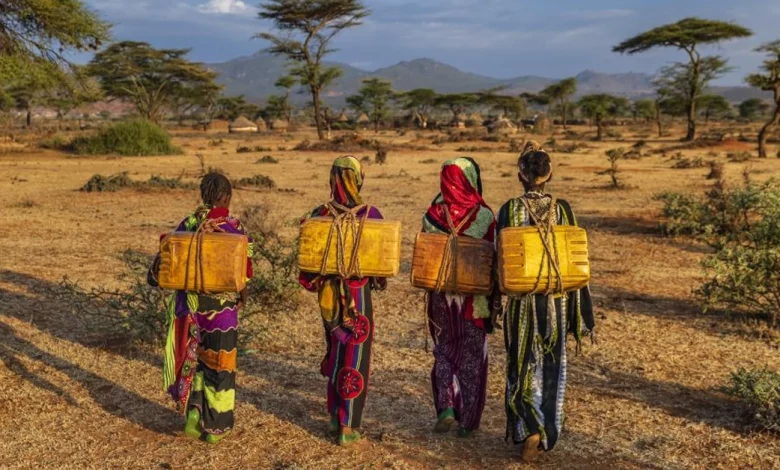Daily Current Affairs for UPSC
El Nino Impact on Food Security: FAO
Syllabus- Geography [GS Paper-1]

Context- The World Meteorological Organization (WMO) recently predicted that El Nino could fuel extreme weather events such as heat waves, forest fires and droughts.
Key Highlights
- The Food and Agriculture Organization of the United Nations (FAO) has launched a plan to reduce the projected effects of the El Nino climate phenomenon on the agricultural livelihoods and food security of the most vulnerable and vulnerable populations.
The formation of El Niño
- El Niño is the result of a complex interaction between oceanic and atmospheric forces. The main catalyst is the weakening of the east-west trade winds, which normally prevail in the tropical Pacific.
- This weakened wind pattern allows warm water from the western Pacific to flow back into the eastern Pacific, causing sea surface temperatures to rise.
The impact of El Niño on global regions
- Oceanic and Atmospheric Effects: El Niño affects ocean temperatures, currents, coastal fisheries, and local weather patterns from Australia to South America and beyond. Warm ocean surface waters increase precipitation due to rising warm air.
- Regional Weather Patterns: Rainfall will increase in South America, increasing coastal flooding and erosion. In contrast, Indonesia and Australia are experiencing dry conditions that cause water bodies to empty and river flows to decline, threatening water-dependent agriculture.
- Asia-Pacific dynamics: Weakened trade winds carry warm surface water to Asia and Australia, raising sea levels and temperatures in Indonesia relative to Ecuador.
- Environmental and health impacts: Areas affected by natural disasters, such as floods and droughts caused by El Niño, are more prone to disease epidemics, including cholera, dengue and malaria. Dry conditions can cause fires, causing breathing problems.
- Positive effect on hurricane frequency: El Niño can have a positive effect by reducing the frequency of hurricanes in the Atlantic.
Impact of El Niño on India
- Effects of Weather and Climate: El Niño has a major impact on the weather and climate of India, especially during the monsoon season. Weaker monsoon rains due to El Niño events exacerbate the drought, with significant events in 2002 and 2009 affecting the country’s water resources.
- Agricultural Sector and Economic Implications: El Niño directly affects the agricultural sector in India by reducing the yield of important summer crops such as rice, sugarcane, cotton and oilseeds. A decline in agricultural production affects the economy, which increases high inflation and slows GDP growth. Impact on water resources: The impact of El Niño can have a devastating impact on India’s water resources, exacerbating the problems of drought and water scarcity.
- Climate Variability and Hazards: El Niño causes changes in temperature, rainfall and storms in India, increasing the risk of floods, landslides and other hazards.
El Niño Southern Oscillation (ENSO)
- Overview of ENSO:
-
-
- ENSO describes the interaction between the tropical Pacific Ocean and the atmosphere, characterized by periodic warming (El Niño) and cooling (La Niña) of the central and eastern Pacific.
- The warming phase is called El Niño, while the cooling phase is called El Niño. to La Niña.
-
- Southern Oscillations and Pressure Fluctuations:
-
- Typical pressure conditions in the South Pacific and Indian Ocean can change during ENSO events, resulting in low pressure in the Pacific and high pressure in the Indian Ocean.
- This change in pressure conditions is known as the Southern Oscillation, which is intricately linked to the El Niño phenomenon.
- The synergy between El Niño and the Southern Oscillation is collectively known as the El Niño Southern Oscillation, which brings together the overall climate patterns and anomalies associated with this phenomenon.
Food and Agriculture Organization
- Information:
-
-
- It is a special agency established by the United Nations in 1945 to lead international efforts to combat hunger.
- It is headquartered in Rome, Italy.
- It aims to inform and support sustainable agriculture through legislation and national strategies with the aim of alleviating hunger.
- Its aim is to achieve food security for all and ensure that people regularly receive enough quality food for an active and healthy life.
-
- Main published publications:
-
- State of World Fisheries and Aquaculture (SOFIA).
- State of the World’s Forests (SOFO).
- The State of World Food Security and Nutrition (SOFI).
Source: DTE
Practice question:
Q.What can be potential impact of El-Nino on Indian monsoon





.png)



